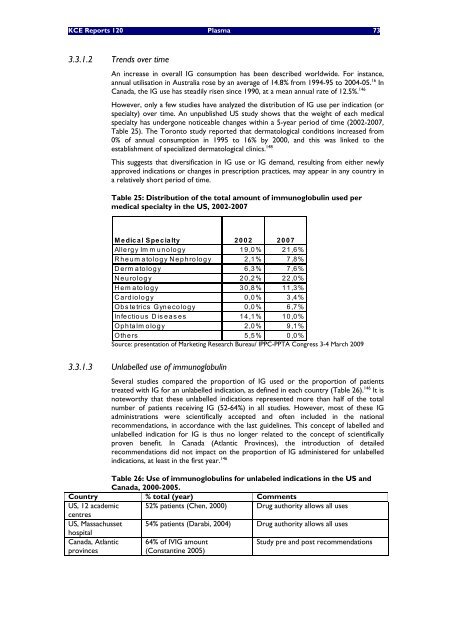The report is available in English with a French summary - KCE
The report is available in English with a French summary - KCE
The report is available in English with a French summary - KCE
Create successful ePaper yourself
Turn your PDF publications into a flip-book with our unique Google optimized e-Paper software.
<strong>KCE</strong> Reports 120 Plasma 73<br />
3.3.1.2 Trends over time<br />
An <strong>in</strong>crease <strong>in</strong> overall IG consumption has been described worldwide. For <strong>in</strong>stance,<br />
annual util<strong>is</strong>ation <strong>in</strong> Australia rose by an average of 14.8% from 1994-95 to 2004-05. 16 In<br />
Canada, the IG use has steadily r<strong>is</strong>en s<strong>in</strong>ce 1990, at a mean annual rate of 12.5%. 146<br />
However, only a few studies have analyzed the d<strong>is</strong>tribution of IG use per <strong>in</strong>dication (or<br />
specialty) over time. An unpubl<strong>is</strong>hed US study shows that the weight of each medical<br />
specialty has undergone noticeable changes <strong>with</strong><strong>in</strong> a 5-year period of time (2002-2007,<br />
Table 25). <strong>The</strong> Toronto study <strong>report</strong>ed that dermatological conditions <strong>in</strong>creased from<br />
0% of annual consumption <strong>in</strong> 1995 to 16% by 2000, and th<strong>is</strong> was l<strong>in</strong>ked to the<br />
establ<strong>is</strong>hment of specialized dermatological cl<strong>in</strong>ics. 148<br />
Th<strong>is</strong> suggests that diversification <strong>in</strong> IG use or IG demand, result<strong>in</strong>g from either newly<br />
approved <strong>in</strong>dications or changes <strong>in</strong> prescription practices, may appear <strong>in</strong> any country <strong>in</strong><br />
a relatively short period of time.<br />
Table 25: D<strong>is</strong>tribution of the total amount of immunoglobul<strong>in</strong> used per<br />
medical specialty <strong>in</strong> the US, 2002-2007<br />
Medical Specialty 2002 2007<br />
Allergy Immunology 19,0% 21,6%<br />
Rheumatology Nephrology 2,1% 7,8%<br />
Dermatology 6,3% 7,6%<br />
Neurology 20,2% 22,0%<br />
Hematology 30,8% 11,3%<br />
Cardiology 0,0% 3,4%<br />
Obstetrics Gynecology 0,0% 6,7%<br />
Infectious D<strong>is</strong>eases 14,1% 10,0%<br />
Ophtalmology 2,0% 9,1%<br />
Others 5,5% 0,0%<br />
Source: presentation of Market<strong>in</strong>g Research Bureau/ IPPC-PPTA Congress 3-4 March 2009<br />
3.3.1.3 Unlabelled use of immunoglobul<strong>in</strong><br />
Several studies compared the proportion of IG used or the proportion of patients<br />
treated <strong>with</strong> IG for an unlabelled <strong>in</strong>dication, as def<strong>in</strong>ed <strong>in</strong> each country (Table 26). 146 It <strong>is</strong><br />
noteworthy that these unlabelled <strong>in</strong>dications represented more than half of the total<br />
number of patients receiv<strong>in</strong>g IG (52-64%) <strong>in</strong> all studies. However, most of these IG<br />
adm<strong>in</strong><strong>is</strong>trations were scientifically accepted and often <strong>in</strong>cluded <strong>in</strong> the national<br />
recommendations, <strong>in</strong> accordance <strong>with</strong> the last guidel<strong>in</strong>es. Th<strong>is</strong> concept of labelled and<br />
unlabelled <strong>in</strong>dication for IG <strong>is</strong> thus no longer related to the concept of scientifically<br />
proven benefit. In Canada (Atlantic Prov<strong>in</strong>ces), the <strong>in</strong>troduction of detailed<br />
recommendations did not impact on the proportion of IG adm<strong>in</strong><strong>is</strong>tered for unlabelled<br />
<strong>in</strong>dications, at least <strong>in</strong> the first year. 146<br />
Table 26: Use of immunoglobul<strong>in</strong>s for unlabeled <strong>in</strong>dications <strong>in</strong> the US and<br />
Canada, 2000-2005.<br />
Country % total (year) Comments<br />
US, 12 academic<br />
centres<br />
52% patients (Chen, 2000) Drug authority allows all uses<br />
US, Massachusset 54% patients (Darabi, 2004) Drug authority allows all uses<br />
hospital<br />
Canada, Atlantic<br />
prov<strong>in</strong>ces<br />
64% of IVIG amount<br />
(Constant<strong>in</strong>e 2005)<br />
Study pre and post recommendations

















